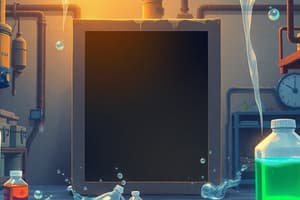Podcast
Questions and Answers
What is the primary purpose of a lubricant?
What is the primary purpose of a lubricant?
- To lessen friction between moving surfaces (correct)
- To increase the weight of tools
- To clean machinery parts
- To dissolve solid waste
Which of the following is NOT a type of lubricant mentioned?
Which of the following is NOT a type of lubricant mentioned?
- Silicon Lubricant
- Anti-rust lubricant spray
- Wire Pulling Lubricant
- Detergent lubricant (correct)
What is the main function of gasoline as a cleaning solvent?
What is the main function of gasoline as a cleaning solvent?
- To remove paint
- To dissolve dirt in water
- To clean rubber surfaces
- To wash greasy tools and equipment (correct)
Which of the following cleaning solvents is used to remove spilled paint?
Which of the following cleaning solvents is used to remove spilled paint?
What does Seiketsu refer to in the 5’s approach?
What does Seiketsu refer to in the 5’s approach?
Which step of the 5’s approach involves eliminating unnecessary items from the workspace?
Which step of the 5’s approach involves eliminating unnecessary items from the workspace?
Which of the following is an effect of practicing self-discipline in the workplace?
Which of the following is an effect of practicing self-discipline in the workplace?
What is the function of kerosene as a cleaning solvent?
What is the function of kerosene as a cleaning solvent?
Flashcards are hidden until you start studying
Study Notes
Lubricants
- Lubricants are substances introduced to reduce friction between moving surfaces and transport external particles.
- Five Types of Lubricants:
- Anti-rust lubricant spray
- Wire Pulling Lubricant
- All Purpose Anti Rust Lubricant
- Lubricant Oil and Engine Oil
- Silicon Lubricant
Cleaning Solvents
- Solvents are components of a solution that dissolve solutes and are usually present in larger proportions.
- Five Types of Cleaning Solvents:
- Gasoline: washes greasy tools and equipment.
- Kerosene: removes dust, grease, oil, paint, etc.
- Thinner: removes spilled paint from floors, walls, and tools.
- Water: washes dust from floors, walls, etc.
- Detergent Soap and Water: washes and cleans benches, tables, cabinets, etc.
5'S Approach
- The 5'S approach is a method of organizing and managing workspaces and workflows to improve efficiency.
- Japanese words and their corresponding English translations:
- Seiri (Sort)
- Seiton (Systematize)
- Seiso (Sweep)
- Seiketsu (Sanitize)
- Shitsuke (Self-discipline)
5'S Approach in Detail:
- Sorting (Seiri): Identifying and eliminating unnecessary items from the workplace and disposing of them.
- Systematizing (Seiton): Arranging necessary items in a specific order for easy access. A place for everything, and everything in its place.
- Sweeping (Seiso): Thoroughly cleaning the workplace ensuring no dust on floors, machines, and equipment.
- Sanitizing (Seiketsu): Maintaining high cleaning standards and organizational hygiene within the workplace.
- Self-discipline (Shitsuke): Training individuals to consistently follow cleaning procedures independently.
Studying That Suits You
Use AI to generate personalized quizzes and flashcards to suit your learning preferences.




